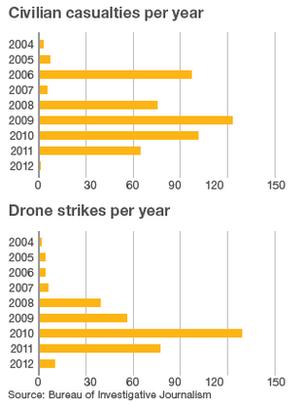Inside America's Drone HQ
- Published
Unmanned aircraft are the new cornerstone of modern military operations, and both American and British crews are learning to fly them at a New Mexico Air Force base. There, they must tackle the practical questions of what it means to wage war from afar.
America and its allies are fighting wars around the world from computer screens in the deserts of Nevada and New Mexico.
Drones - officially known as remotely piloted aircraft - have become a major part of modern warfare.
These unmanned aircraft have the ability to fly above contentious areas, taking and relaying surveillance photos. The most controversial drones have the ability to launch an attack via onboard weapons.
America operates thousands of drones, with the bigger, more sophisticated versions controlled from bases in the US.
More pilots are being trained to fly American unmanned aircraft than fighter planes, and most of them are put through their paces at Holloman Air Force Base in New Mexico.
It's the biggest drone pilot training centre in the world, with American and British crews learning to fly them, spy with them and fire missiles from them.
'Not robot warfare'
The two common armed drones are the Predator and the Reaper, and Colonel Ken Johnson, 49th Operations Group commander at Holloman, showed me around them both.
They have high-tech cameras and weapons mounted under the wings. They're smaller than you might imagine with a grey hump where the glass cockpit would normally be.

"There's always going to be a human crew controlling the aeroplane," he said, explaining why he preferred the term 'remotely piloted aircraft' to 'drone'.
"So they're not robots. This is not robot warfare."
Some took off from the runway, controlled from inside the small, innocuous khaki-coloured shipping containers packed with all the necessary computer power.
In other darkened rooms on the base, pilots ran through training exercises on simulators.
"You can use the shadow patterns and the colours in the picture to identify if the man is carrying a weapon," a female US trainer explained to one of the British Royal Air Force students.
We were allowed to watch but not give the surname of any pilots or navigators as they learned and practised.
The bank of screens displayed maps and an aerial view of buildings, roads and computer-generated men walking - some carrying guns.
"It's a basic intelligence, surveillance and reconnaissance trip - a two and a half hour mission," explained Squadron Leader "Dex", an instructor, but also commander for UK forces at the base.
One person flies the drone, the other operates the cameras and sensors.
They clearly give a huge advantage to troops on the ground, but there's controversy surrounding the American use of drones.
CIA's black hole
In Pakistan, covert missile strikes are launched on suspected insurgents in a country not at war with the US.
Who is targeted, why and who's next on the strike list is a secretive process, and there have been reports of civilian casualties in unmanned air attacks.
"For the covert US drone programme there needs to be a lot more transparency and accountability," said Sarah Holewinski, executive director of the Campaign for Innocent Victims in Conflict (CIVIC).
"With the military's drones we know how they are operated - some is confidential, but we know what happens there. When it comes to the CIA's use of drones it's a complete black hole.
"For civilians living on the ground they don't know whether they are going to be targeted the next day, or at the market if they are standing next to somebody who is a target."
The military dismisses descriptions such as "targeted assassinations" for strikes on suspected fighters in Pakistan or on men not convicted of any crime.
"I think it's only controversial in terms of the media - they will make it controversial," said Sqdr Ldr Dex.
"We train to operate a weapon system in exactly the same way we would train in a manned aircraft - and we do the same job.
"So to us there's nothing controversial about it. Through our training and our smart decisions we avoid collateral damage as best we can. All of our engagements, all of our missions are legitimate and legal."
And what of the psychological impact on troops fighting a war in Afghanistan during the day and then picking up the children from school on the way home to dinner?
Sqdr Ldr Dex says it's part of the training - and the long drive home through the desert from the base helps leave his working day behind him.
But fighting and killing from thousands of miles away as if it were a computer game is a very different way of fighting a war.
These are moral, and legal debates, which will intensify the more we depend on unmanned aircraft to fight our wars.
It appears to be the future, as nations around the world invest in the technology, but it's already very much in the present.